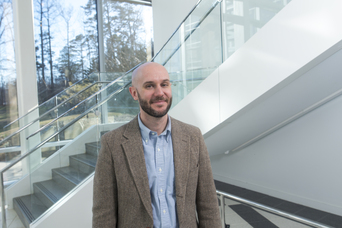“Whether it’s a ship, a bridge, or a building, we collect all kinds of data over its life cycle, but we don’t do a good job of tracking that data over time to find long-term trends.”
— David Lattanzi, associate professor in the Sid and Reva Dewberry Department of Civil, Environmental, and Infrastructure Engineering

Civil engineering associate professor David Lattanzi is developing new methods to categorize and leverage data to assess structures’ condition and possibilities for future use.
When Dave Lattanzi worked as a structural inspector, he saw that the way that civil engineers monitored, inspected, and maintained buildings, tunnels, and other structures could be smarter and more efficient.
“There weren’t any quantitative techniques we could use. Everything was very subjective,” says Lattanzi, the John Toups Faculty Fellow in civil engineering and associate professor in the Sid and Reva Dewberry Department of Civil, Environmental, and Infrastructure Engineering.
“Whether it’s a ship, a bridge, or a building, we collect all kinds of data over its life cycle,” he says, “but we don’t do a good job of tracking that data over time to find long-term trends.”
Lattanzi figured there had to be a better way, so he and a team of five Mason students are developing new methods to categorize and leverage data to assess structures’ condition and possibilities for future use.
He has applied this method to many types of infrastructure for years and is now exploring new data-driven approaches to the life cycle monitoring and assessment of U.S Navy ships.
One approach is the creation of a “digital twin” of a ship, a complex virtual model that evolves with the physical ship, which will provide a platform for visualization and assessment. “The digital twin will be filled with the information we collect about the ship over time,” Lattanzi says.
In theory, this data would improve decision making. For instance, if the Navy wants to deploy a 15-year-old vessel, they can look to the digital twin for clues on what situations the ship can withstand, including whether it can go into rougher water, he says.
Lattanzi, who has received more than $400,000 in funding from the Office of Naval Research, is working with Navy researchers to assess the strength and capacity of ships through advanced sensing methods. Plus, he provides training and guidance to naval researchers and staff on advanced sensing and reconnaissance techniques.
His research is also supported by a faculty fellowship through a gift from the late John Toups, an entrepreneur, civil engineer, and Northern Virginia businessman. “The fellowship is helping me explore the digital twin idea and share my findings with the professional and academic community,” Lattanzi says.
“John Toups was an impressive community and professional leader, and it’s a tremendous honor to hold a fellowship in his name. I’m glad I had the opportunity to meet him.”
This story appeared in Mason's Spirit magazine.
